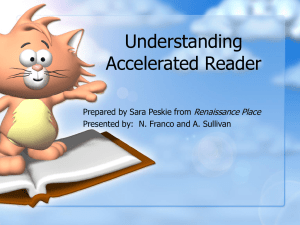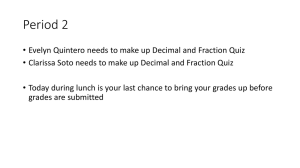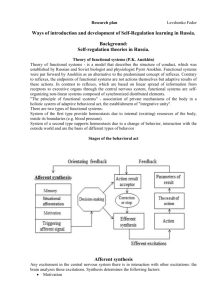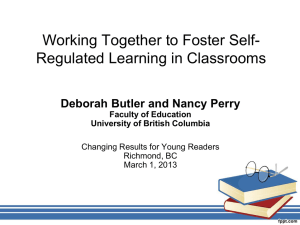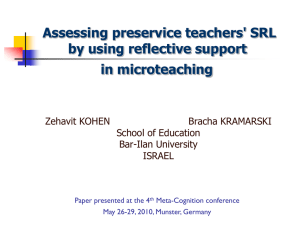view - West Texas Middle School Math Partnership
advertisement
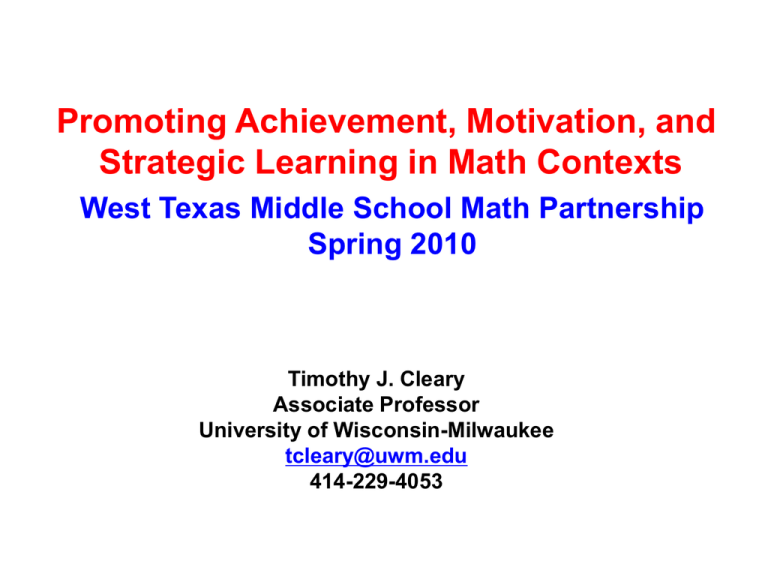
Promoting Achievement, Motivation, and Strategic Learning in Math Contexts West Texas Middle School Math Partnership Spring 2010 Timothy J. Cleary Associate Professor University of Wisconsin-Milwaukee tcleary@uwm.edu 414-229-4053 Dan, a 12 year old student in the 6th grade at an urban middle school, has been reported by his teachers to exhibit academic and motivational difficulties. More specifically a few of his teachers expressed concern about his poor test performance and inconsistent homework completion, his tendency to give up easily when attempting to complete topics, and his overall negative attitudes about school. Math is particularly difficult for Dan as he fails most tests and rarely participates in class activities. His parents revealed that Dan is a “poor studier” and over the past couple of years has developed a sense of helplessness about his school because he does not really understand why things are so difficult. Maladaptive behaviors Maladaptive beliefs and attitudes Poor academic performance Intervention Baseline Strategy Plan - Looked over stuff -Read my notes Strategy Plan Same Strategy Plan Strategy Plan -Index -cards - Study plan - Graphic organizer - Index cards - Study plan Strategy Plan - Study Strategy plan Plan - Graphic Read notes organizer - Mother quizzed him Link between self-regulation and math performance Poor performance in math could be attributed to ineffective prior math instruction, but also often involves: deficiencies in SRL skills such as: - overestimating their math proficiency, which may result in “under” preparation for exams - failing to self-evaluate their efforts to learn accurately - failing to attribute errors to shortcomings in strategy - failing to adapt their maladaptive approaches to subsequent math problems …how we can cultivate adaptive regulatory thoughts and actions that promote motivation and achievement in math Primary Objectives of Lecture 1. To briefly describe a three-phase cyclical model of self-regulation 2. To highlight a couple of instructional tactics to enhance student motivation and math achievement - type of feedback - graphing/progress monitoring - attribution training - forethought training - error analysis - cognitive modeling - self-monitor - guided practice Thinking in the language of strategies Characteristics of a self-regulated learner? 1,2 • Highly self-motivated, proactive • Set goals and develop/use strategic plans • Monitoring strategies and performance • Frequent self-reflection and analysis ADJUST or CHANGE strategies and goals To optimize future performance Cycle of Self-Regulatory Thought and Action 1 Performance Phase Self-Control Self-Instruction Imagery Attention Focusing Task Strategies Forethought Phase Self-Observation Self-recording Metacognitive Monitoring Self-Reflection Phase Task Analysis Goal Setting Strategic Planning Self-Judgment Self-Evaluation Causal Attributions Self-Motivational Beliefs Self-efficacy Outcome expectations Intrinsic Interest Goal Orientation Self-Reaction Self-satisfaction/affect Adaptive Inferences Developing strategic reflective thinkers 1. Attributions following failure 3 Has there been any activity or experience which proved to be especially challenging or difficult for you? (something you were not very good at doing). What types of thoughts did you have immediately following poor performance? What did you think was the reason for your performance and how did you feel? Can be categorized across three broad dimensions: a)Internal/External - is the cause a personal or environmental phenomenon? b) Controllable/Uncontrollable - is the cause under a person’s control or not? c) Stable/Unstable - is the cause easily modified or changeable? Types of attributions we make following failure impacts our subsequent behaviors and affect Attribution What is the main reason why you failed your last math test? Adaptive Inference What do you need to do to improve your next test grade? Attributions not under student control “The Cowboys lost again last night” “Test was too hard” “The teacher is not any good” “The teacher does not like me” “I don’t know” Uncontrollable Now what??? Under student control/internal/unstable “I did not try hard enough” “I did not use the correct STRATEGY” Attribution What is the main reason why you failed your last math test? Strategy Adaptive Inference What do you need to do to improve your next test score? Change my strategy I forgot how to do the step for getting all variables on one side of the equation Ask the teacher or classmates about this method I did not think about the type of problem before trying to solve it Use the math strategy that my teacher taught me Cycle of Self-Regulatory Thought and Action 2 Performance Phase Self-Control Self-Instruction Imagery Attention Focusing Task Strategies Forethought Phase Self-Observation Self-recording Metacognitive Monitoring Self-Reflection Phase Task Analysis Goal Setting Strategic Planning Self-Judgment Self-Evaluation Causal Attributions Self-Motivational Beliefs Self-efficacy Outcome expectations Intrinsic Interest Goal Orientation Self-Reaction Self-satisfaction/affect Adaptive Inferences 2) Error Analysis – A self-regulation perspective • Problem solving errors are not signs of imperfection but rather are essential sources of guidance for SRL • Students should be taught to reflect carefully upon the errors they make because such errors reveal alternative ways to solve math problems • Enhanced efficacy and SRL behaviors occur when students make successful adaptations from errors • Students should be praised and graded favorably for recognizing and overcoming errors rather than criticized and penalized for making them. Zimmerman, Hudesman, Flugman & Moylan (2010) • The goal of this project was to prepare students to respond to their academic grades as sources of selfregulated learning rather than as indices of personal limitation. • Examine the efficacy of an SRL intervention involving strategic instruction (classroom level) and self-reflection training (individuals) on student motivation, self-regulation and math achievement What was the nature of the SRL intervention? Classroom-based strategy instruction • strategic instruction in error analysis • coping modeling techniques and guided practice Focus on self-reflection following quiz performance • frequent math quizzes (every 2-3 days) • an SRL Math Self-Assessment Form designed to guide students’ self-reflection processes during math problem corrections Classroom-based strategy instruction A. Strategic Instruction • Teacher models specific strategies at each step of the problem – use of think alouds – teacher makes deliberate errors during presentation – teacher models identifying errors and coping tactics – math solution errors are used as a departure point for analysis, i.e. teachers don’t just start over or quickly correcting errors themselves • Teacher writes down strategies clearly on the board in words B. Increased Practice and Feedback • Teacher sets aside time for students to engage in individual practice of strategies for problem solving and error detection • Teacher asks students to verbalize error detection/ problem solving strategies while reviewing or working through practice problems • Teacher asks students to check their understanding (discuss answers to problems and errors) with peers in pairs or groups Self-regulation instruction following performance a) Math quizzes (4-5 problems) every 2 to 3 classes (returned that day or the following day) b) Following each quiz, students were instructed to complete a Self-assessment Form a) Compare self-efficacy and self-evaluation estimates with actual quiz performance (calibration accuracy) b) Explain their ineffectual strategies (attributions) c) Establish new effective strategies (adaptive inferences) Quiz Reflection Form: Error Analysis PLAN IT 1 a. How much time did you spend studying for this quiz? _______ b. How many practice problems did you do in this topic area __________in preparation for this quiz? (circle one) 0 – 5 / 5 – 10 / 10+ c. What did you do to prepare for this quiz? (use study strategy list to answer this question) 2. After you solved this problem, was your confidence rating too high (i.e. 4 or 5)? Yes/no 3. Explain what strategies or processes went wrong on the quiz problem. Quiz Reflection Form: Strategic Practice PRACTICE IT 4. Now re-do the original quiz problem and write the strategy you are using on the right. 2x 7 x 9 x2 2 Quiz Reflection Form: Transfer of Knowledge 5. How confident are you now that you can correctly solve this similar item? 6. Now use the strategy to solve the alternative problem. x 4x 8 x3 2 7. How confident are you now that you can correctly solve a similar problem on a quiz or test in the future? Who was the target population? • Student population 13,370 - 37.1% Black (non-Hispanic) 28.6% Hispanic 15.9% Asian/Pacific Islander 11.6% White (non-Hispanic) 0.3% Native American 7% Other • 80% of incoming freshmen receive need-based aid • Graduation rate for associate degree students averages 21% after six years • Only 38% of entering freshmen pass the entrance exam in mathematics Research Design • This study involves a developmental math course and an introductory college-level math course. In both course levels, students are randomly assigned to either the SRL or control classroom. • Control classrooms received traditional remedial or college-level math instruction plus the quizzes. • The two groups were compared using multiple examination measures and course-related selfregulatory measures. Math Achievement Measures • Math periodic exams. Three uniform, cumulative math tests that were administered during the semester were used as problem-solving performance measures. • Math final exam. Comprehensive, department-wide final exam scores were used as another achievement measure. Self-Evaluation Measures • Self-evaluation. To measure post-performance selfevaluative judgments, students rated their confidence that their responses were correct using the same scale as for the self-efficacy measure. • Self-evaluation bias. Bias calibration of postperformance self-evaluative judgments was assessed similarly to self-efficacy bias. Math Exam Results 80 70 Math Grades 60 50 Intervention 40 Control 30 20 10 0 Periodic Math Exam Final Math Exam Types of Math Exams Self-Regulation Results 4 3.5 Self-Ratings 3 Intervention Control 2.5 2 1.5 1 0.5 0 Self-Efficacy Self-Evaluation Self-Efficacy Bias Self-Evaluation Bias Self_Regulation Measures Self-Reflectors’ Math Exam Results 80 70 Exam Grades 60 50 High Self-Reflectors 40 Low Self-Reflectors 30 20 10 0 Periodic Final Type of Math Exams Self-Reflectors’ Self-Regulation Results 4 3 High Self-Reflectors 2.5 Low Self-Reflectors 2 1.5 1 0.5 as Ev al ua tio n Bi as Bi Se lf- ca cy Ef fi Se lf- Ev al ua tio n Se lf- Ef fi -0.5 ca cy 0 Se lf- Self-Ratings 3.5 Self-Regulation Measures Conclusions • SRL students surpassed control students on periodic exams as well final exams – greater reflection opportunities and strategic liearning led to higher performance • SRL students reported less over-confidence than control students in both their math self-efficacy beliefs and selfevaluative judgments • SRL students who engaged in greater error correction and self-reflection displayed higher math exam grades and calibration than students who were low in error correction • Although self-efficacy and self-evaluation measures were correlated positively with periodic and final math exam performance, the SRL intervention did not influence these self- beliefs How can we create a shift in students’ strategic thinking? Talking in the language of strategies • interpret failure/mistakes in terms of strategies • link errors to strategies • model and allow practice for error correction • set strategic goals and strategic plans • self-monitoring strategy use link




